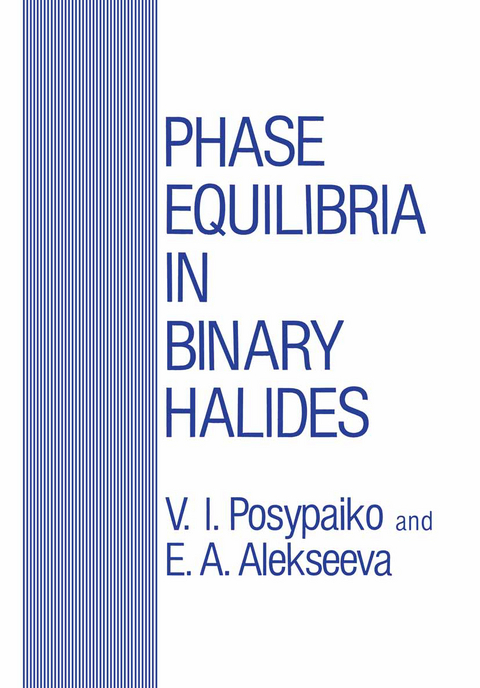
Phase Equilibria in Binary Halides
Springer-Verlag New York Inc.
978-1-4684-9026-8 (ISBN)
Molten salts have been used for many years in a large number of industrial applications, and interest in them has increased mark edly in the present century. There is a vast amount of experi mental data published on molten salt systems, and much of this is due to Russian workers. In 1961 the Russian Academy of Sciences published a manual dealing with work in the period 1886-1955. These were updated in 1979 with the publication of a 3-volume collection of binary phase diagrams. The present volume is a translation of the Russian books but is restricted to the systems involving halides. In order to keep the length of the book within bounds the data have been recast. The Russian work treats each system in detail, giving data, methods of study, references, and figures, where available, all together. In this translation all the information is given, but to keep the length down the methods have been classified, the references collected at the end of the volume, and the data given in tabular form. All the figures for halide systems in the Russian volume are included. In the tables, concentrations are given in mole percent; in some cases these have been converted from weight per cent in the original Russian. Where the Russian work was. in tabular form, these have been translated as given. Where the figures exist, these are referred to in the text.
AgBr.- AgCl.- AgI.- AlBr3.- AlCl3.- AlF3.- AlI3.- AsCl3.- AsI3.- BCl3.- BF3.- BaBr2.- BaCl2.- BaF2.- BaI2.- BeCl2.- BeF2.- BiBr3.- BiCl3.- BiI3.- CaCl2.- CaF2.- CaI2.- CdBr2.- CdCl2.- CdF2.- CdI2.- CeCl3.- CeF3.- CoBr2.- CoCl2.- CoF2.- CoI2.- CrCl2.- CrCl3.- CrF2.- CrF3.- CsBr.- CsCl.- CsF.- CsI.- CuBr.- CuCl.- CuCl2.- CuF2.- CuI.- DyCl3.- DyF3.- DyI3.- ErCl3.- ErF3.- ErI3.- EuCl2.- EuCl3.- EuF3.- FeCl2.- FeCl3.- FeF2.- FeF3.- FeI2.- GaBr.- GaBr3.- GaCl2.- GaCl3.- GaF3.- GaI3.- GdCl3.- GdF3.- GdI3.- GeBr4.- GeCl4.- GeI4.- HfBr4.- HfCl4.- HfF4.- HfI4.- HgBr2.- HgCl.- Hg2Cl2.- HgCl2.- HgI2.- HoCl3.- HoF3.- InBr3.- InCl.- InCl3.- InF3.- InI.- InI2.- InI3.- KBF4.- KBr.- KCl.- KF.- KI.- LaCl3.- LaF3.- LaI3.- LiBr.- LiCl.- LiF.- LiH.- LuCl3.- LuF3.- MgCl2.- MgF2.- MnCl2.- MnF2.- MoCl3.- MoCl5.- MoF6.- NH4Br.- NH4Cl.- NH4F.- NaBF4.- NaBr.- NaCl.- NaF.- NaI.- NbCl2.- NbCl3.- NbCl4.- NbCl5.- NbF5.- Nb3I8.- NdCl3.- NdF3.- NiCl2.- NiF2.- PbBr2.- PbCl2.- PbF2.- PbI2.- PrCl3.- PrF3.- PuCl3.- PuCl4.- PuF6.- RbBr.- RbCl.- RbF.- RbI.- ReCl3.- ReCl5.- SbBr3.- SbCl3.- SbCl5.- SbF5.- SbI3.- SeCl4.- SmCl3.- SmF3.- SnBr2.- SnBr4.- SnCl2.- SnCl4.- SrBr2.- SrCl2.- SrF2.- TaCl5.- TaF5.- TeBr4.- TeCl4.- TeI4.- ThCl4.- ThF4.- TiBr4.- TiCl4.- TlBr.- TlBr2.- TlCl.- TlF.- UCl3.- UCl4.- UF3.- UF6.- VF5.- WCl6.- XeF2.- ZnCl2.- ZrBr4.- ZrCl4.- References.
| Zusatzinfo | 496 p. |
|---|---|
| Verlagsort | New York, NY |
| Sprache | englisch |
| Maße | 178 x 254 mm |
| Themenwelt | Naturwissenschaften ► Chemie ► Anorganische Chemie |
| ISBN-10 | 1-4684-9026-5 / 1468490265 |
| ISBN-13 | 978-1-4684-9026-8 / 9781468490268 |
| Zustand | Neuware |
| Haben Sie eine Frage zum Produkt? |
aus dem Bereich


